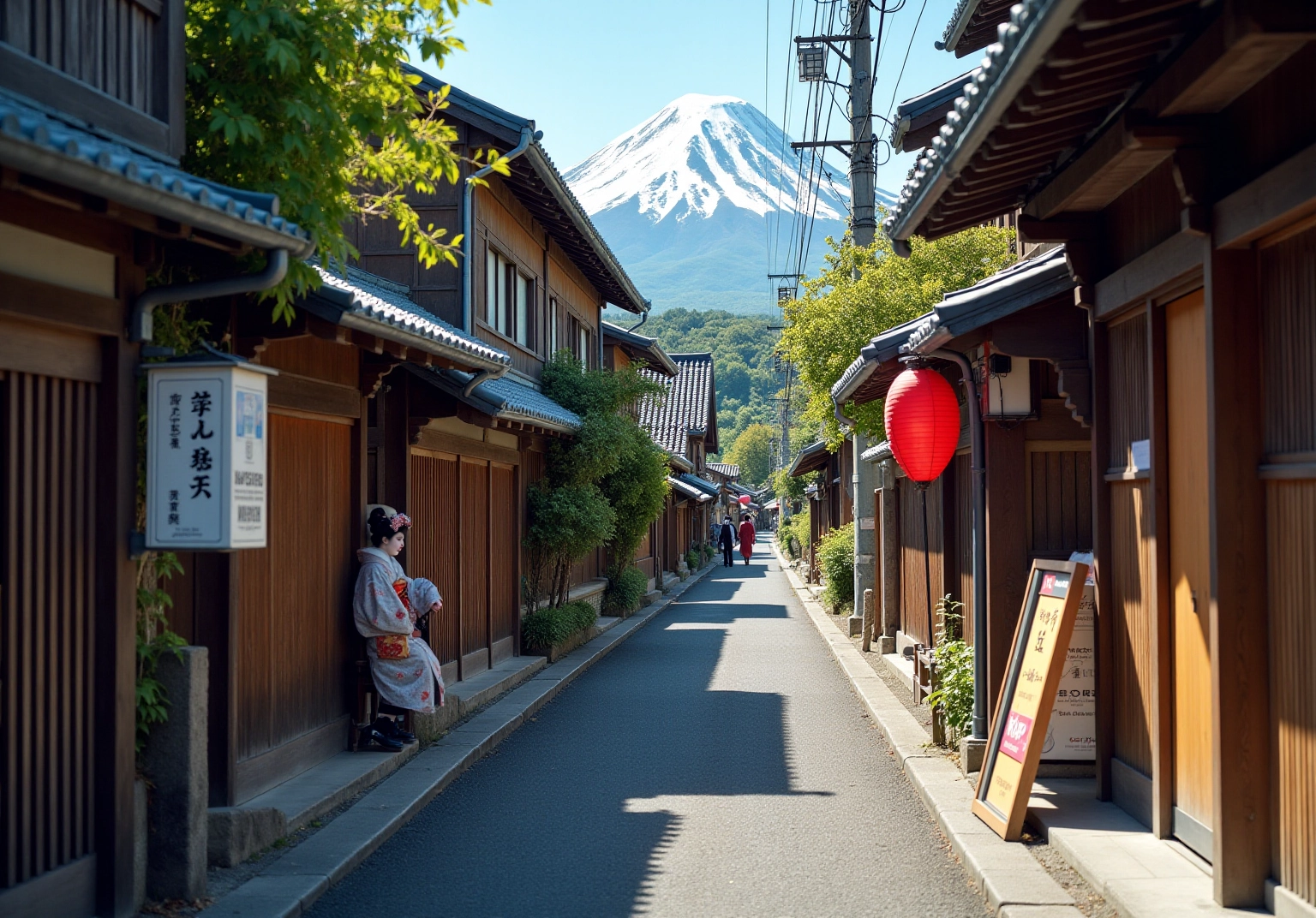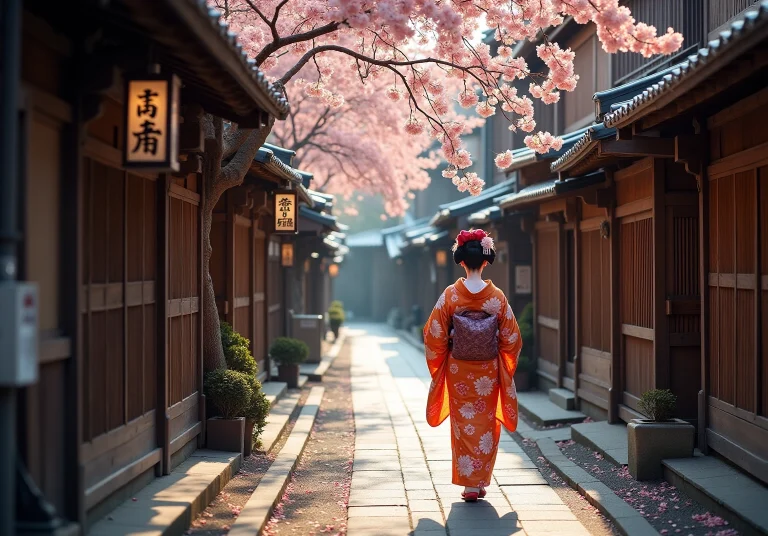Overview
Japan’s recent decision to ban tourists is all about preserving its rich cultural heritage and tackling the challenges of overtourism, especially in popular spots like Kyoto and Mount Fuji. Imagine wandering through these iconic places without the crowds! New regulations are stepping in to make this a reality.
You’ll find:
- Limited access to certain streets
- Daily visitor caps
- Compliance requirements like the J-ESTA
These measures are designed to encourage sustainable tourism practices that honor local traditions and protect the environment. So, if you’re planning a trip, get ready for a more thoughtful and immersive experience!
Key Highlights:
- Japan’s tourist ban aims to preserve cultural heritage and address overtourism challenges, with 36 million international visitors in 2024.
- Kyoto, with a 29.5% visit rate, has implemented a daily tourism levy to manage crowds and protect historical sites.
- Access to certain streets in Kyoto’s Gion district is restricted to safeguard local culture and heritage.
- New regulations for Mount Fuji include a daily climber limit of 4,000 and a climbing fee of 2,000 yen starting July 1, 2024.
- From June 16, 2025, travellers from visa-exempt countries must apply for J-ESTA and have private health insurance.
- Respectful tourism practises include maintaining quietness in public transport, avoiding tipping, and engaging in local cultural experiences.
- Over 82% of visitors prioritise experiencing Japanese cuisine, underscoring its cultural significance.
Introduction
Japan’s recent decision to ban tourists from certain areas is a fascinating move that reflects a growing concern over the impact of overtourism on its cherished cultural heritage. With millions of visitors flocking to iconic sites each year, the delicate balance between welcoming guests and preserving local traditions has become increasingly precarious.
In this article, I’ll dive into the rationale behind these restrictions, highlighting the key locations affected and the compliance requirements that you, as a traveler, must navigate.
As Japan embarks on this journey towards sustainable tourism, it raises an intriguing question: how can you engage meaningfully with the culture while respecting the new regulations?
Let’s explore this together!
Explore the Rationale Behind Japan’s Tourist Ban
The decision of Japan banning tourists is aimed at preserving its incredible cultural heritage and tackling the challenges of overtourism. Can you believe that in 2024, the nation welcomed 36 million international visitors? That’s a lot of foot traffic at popular sites, putting regional traditions and the environment at risk. Take Kyoto, for instance. With a whopping 29.5% visit rate and 7.4 million visitors, it’s no wonder they’ve introduced a daily tourism levy to manage the crowds and protect those stunning classical Buddhist temples and traditional architecture.
To safeguard its cultural sites and ensure that tourism benefits nearby communities rather than overwhelming them, Japan is taking steps, including Japan banning tourists from accessing certain areas. This approach reflects a growing global trend where countries are embracing sustainable tourism practices that honor local cultures and environments. As Karen LeBlanc points out, every destination has a unique story to tell through its regional art, architecture, and culture. Her insights remind us that authentic experiences come from understanding and respecting local traditions.
By promoting less-frequented spots and raising daily visitor fees, Japan is not only managing tourism sustainably but also encouraging deeper connections with its rich heritage. As the nation navigates this intricate landscape, it’s clear that responsible tourism is vital for honoring the beautiful tapestry of its cultural legacy. So, are you ready to explore Japan with a fresh perspective?
Identify Key Locations Impacted by the Ban
The recent visitor restrictions, including Japan banning tourists, are shaking things up at some iconic spots, especially in Kyoto’s Gion district! Here, access to certain streets has been limited to help protect the local culture and heritage. This move comes as a response to growing concerns about over-tourism, with residents expressing worries that Japan banning tourists may be necessary to address disrespectful behavior towards geisha entertainers and to preserve traditional settings. You’ll notice new signage letting tourists know that some streets are private, and there are fines of 10,000 yen for violations. But don’t worry—public access to popular attractions like Yasaka Shrine remains unaffected!
And it’s not just Gion feeling the impact. Mount Fuji is also stepping up its game with new regulations to manage the influx of climbers. Starting July 1, 2024, there will be a daily limit of 4,000 climbers, along with a climbing fee of 2,000 yen. These measures aim to tackle environmental concerns while ensuring a sustainable experience for everyone. With the total visitor count to the nation expected to soar past 32 million in 2024, smart management strategies are essential in these popular destinations to navigate challenges such as Japan banning tourists.
Other regions, like the historic temples in Nara and the vibrant streets of Shibuya, are also tightening restrictions to maintain the integrity of these culturally significant sites. If you’re planning to explore Japan, it’s a great idea to stay updated on these changes so you can navigate your journey effectively and show respect for local customs and regulations. Happy travels!

Understand Compliance Requirements for Tourists
Starting June 16, 2025, if you’re planning a trip to this beautiful country, there are a few new compliance requirements you’ll want to keep in mind! One of the key changes is the introduction of the J-ESTA (Electronic System for Travel Authorization). This means that travelers from visa-exempt countries need to apply online before arriving. It’s a simple step that ensures your journey starts off on the right foot!
In addition to that, all visitors are now required to have private health insurance to cover any potential medical expenses during their stay. This is a vital measure aimed at easing the burden on the country’s healthcare system, which has faced challenges due to unpaid medical bills from international guests. With an incredible surge in visitors—14.4 million in just the first four months of 2025, including 3.91 million international arrivals in April alone—it’s more important than ever to ensure you have sufficient health coverage.
To help you avoid any hiccups upon arrival, make sure to prepare all necessary documentation well in advance. This includes:
- Proof of your health insurance
- J-ESTA application confirmation
Taking these steps will help ensure a smooth entry into the country, allowing you to focus on what really matters: enjoying your adventure!

Adopt Best Practices for Respectful Tourism in Japan
To ensure a respectful and enriching travel experience in Japan, you’ll want to familiarize yourself with the regional customs and etiquette. For starters, maintaining quietness on public transport is key—noise can be quite disruptive in shared spaces! And here’s a tip: tipping is typically not observed in Japan. Outstanding service is simply the norm, so giving a gratuity might actually be seen as disrespectful. Also, being mindful of personal space is crucial, as the Japanese really value harmony and comfort in social interactions.
Respecting restricted areas and adhering to posted guidelines, especially in culturally significant sites, is essential for preserving the integrity of these locations. Want to dive deeper? Interacting with nearby communities through workshops or guided tours can really enhance your understanding and appreciation of Japan’s rich cultural heritage. For instance, participating in a traditional tea ceremony or a calligraphy class can provide insights into the values and artistry that define Japanese culture. Plus, don’t miss out on local cooking classes or craft workshops—they allow for hands-on engagement with Japanese traditions!
Did you know that over 82% of visitors prioritize experiencing Japanese cuisine? It really highlights the importance of food as a cultural gateway! With around 47,693,800 visitors expected in 2025, it’s more important than ever to practice considerate travel habits. You might also consider bringing small courtesy gifts for new acquaintances—this practice fosters goodwill and respect in social interactions. By adopting these best practices and engaging in interactive cultural experiences, you can contribute to a more sustainable and respectful tourism environment, creating positive interactions and lasting memories during your travels in Japan!
Conclusion
Japan’s recent decision to impose restrictions on tourist access is a significant step towards preserving its cultural heritage and tackling the challenges of overtourism. This initiative underscores the importance of sustainable tourism practices that honor local traditions and environments. It allows Japan to protect its unique cultural tapestry while still welcoming visitors like you!
Key measures, such as the introduction of the J-ESTA for travel authorization and mandatory health insurance for tourists, reflect a proactive approach to managing the influx of visitors. Plus, specific locations like Kyoto’s Gion district and Mount Fuji are implementing targeted restrictions to maintain the integrity of their cultural sites. These strategies not only help reduce the impact of tourism on local communities but also encourage deeper, more meaningful connections between travelers and Japan’s rich heritage.
As the landscape of travel in Japan evolves, embracing respectful tourism practices becomes increasingly vital. By understanding local customs, adhering to regulations, and engaging in cultural experiences, you can contribute to a sustainable tourism environment. Exploring Japan with a renewed perspective is not just about visiting iconic sites; it’s about honoring the stories and traditions that define this remarkable nation. So, are you ready to embark on this adventure?
Frequently Asked Questions
Why has Japan decided to ban tourists from certain areas?
Japan’s decision to ban tourists from certain areas is aimed at preserving its cultural heritage and addressing the challenges of overtourism, which threatens regional traditions and the environment.
How many international visitors did Japan welcome in 2024?
In 2024, Japan welcomed 36 million international visitors.
What specific measures has Kyoto implemented to manage tourism?
Kyoto has introduced a daily tourism levy to manage crowds and protect its classical Buddhist temples and traditional architecture.
What is the purpose of Japan’s approach to sustainable tourism?
Japan’s approach aims to safeguard cultural sites, ensure that tourism benefits nearby communities, and promote sustainable practices that respect local cultures and environments.
How does Karen LeBlanc’s perspective contribute to the discussion on tourism in Japan?
Karen LeBlanc emphasizes that every destination has a unique story told through its regional art, architecture, and culture, highlighting the importance of understanding and respecting local traditions for authentic experiences.
What strategies is Japan using to promote responsible tourism?
Japan is promoting less-frequented spots and raising daily visitor fees to manage tourism sustainably and encourage deeper connections with its cultural heritage.


































